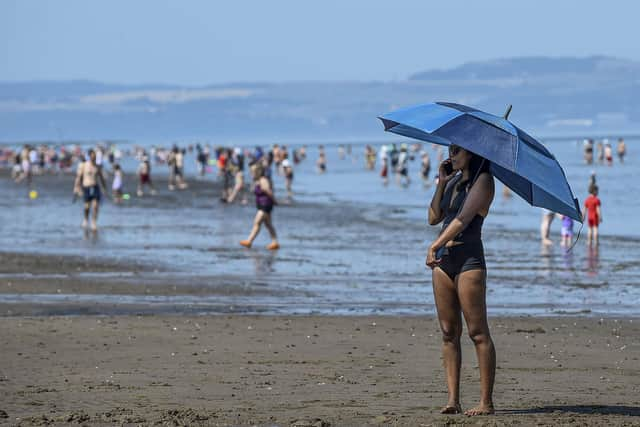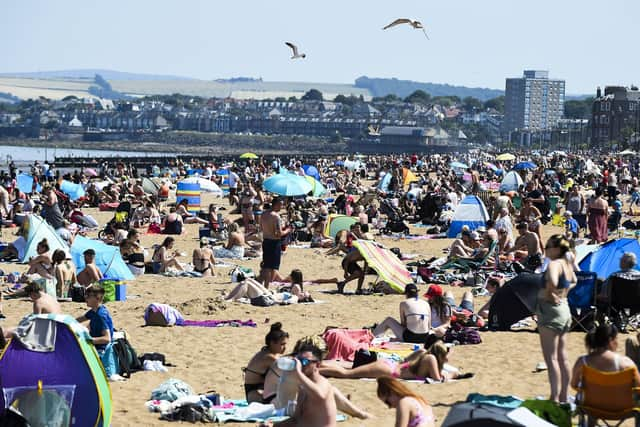UK heatwave: Scottish temperature set to be broken as extreme conditions branded climate emergency 'wake-up call'
and live on Freeview channel 276
With dangerously high temperatures of 41C forecast across parts of England, the conditions are causing widespread disruption south of the border, with delays on the transport network, schools closed, and hospital surgeries cancelled because operating theatres are too hot.
The comparatively milder conditions in Scotland have also exposed weaknesses in the infrastructure, with ScotRail imposing widespread speed restrictions to try and reduce potential damage to rail lines and overhead wires.
Advertisement
Hide AdAdvertisement
Hide AdWhile temperatures reached as high as 30.2C in Aboyne and 30C in Edinburgh on Monday afternoon, meteorologists say it will be even hotter on Tuesday.
The Met Office has predicted the mercury will reach 36C in Jedburgh and 35C Hawick in the Scottish Borders by 2pm.
If realised, that would easily overtake Scotland’s all-time record high temperature of 32.9C, which was set nearly 19 years ago in Greycrook in the Borders.
In a sign of the challenges posed by such temperatures, Scottish Borders Council said it would be running an earlier waste collection service in Hawick to try and make conditions more bearable for staff.
Advertisement
Hide AdAdvertisement
Hide AdHowever, it will be even hotter in England, where 37.5C was recorded in Cavendish, Suffolk, at 3pm on Monday. The Met Office has forecast temperatures of as high as 41C in Worksop, Nottinghamshire, for the afternoon, which would surpass the existing UK record of 38.7C, recorded in Cambridge in 2019.


Met Office meteorologist Luke Miall said: "I've been a qualified meteorologist for ten years, and telling people about 41C in the UK doesn't seem real.
"It's crazy how we are talking about these sorts of values. I've never seen the models coming up with these values. It's been quite an eye-opener to climate change with all these temperatures in the UK."
Dr Hannah Cloke, a physical geographer at the University of Reading who specialises in forecasting floods, droughts, heatwaves, and other natural hazards, said the red warning for extreme heat should be “a wake-up call a bout the climate emergency”.
Advertisement
Hide AdAdvertisement
Hide Ad“Even as a climate scientist who studies this stuff, this is scary,” she said. “This feels real.”


It comes as Professor Penny Endersby, the Met Office’s chief executive, said some people were failing to take unprecedented warnings about the temperatures seriously.
The Met Office issued its first ever red warning for extreme heat, covering areas of England. An amber warning is also in place throughout Tuesday across much of southern and eastern Scotland.
The rise in temperatures has also forced the UK Health Security Agency to issue a level four heat-health alert for England, described as an "emergency”.
Advertisement
Hide AdAdvertisement
Hide AdSuch warnings, Prof Endersby stressed, were not being heeded by everyone. "They think we shouldn’t be telling them to worry about heat the way they should when we tell them to worry about storms or wind,” she said.
"These temperatures are unprecedented and we’re not used to dealing with them. Heat causes many hundreds or thousands excess deaths, so people need to follow the advice of keeping the shade, keeping cool and hydrated."
On Scotland’s rail network, there were cancellations and delays after the heat caused the overhead lines between Glasgow Queen Street low level and Hyndland to trip and reset. Engineers from Network Rail later discovered the heat was also causing the lines to sag.
Speed restrictions on key rail routes were also in place between 1pm and 8pm on Monday, as a result of the high temperatures, which can cause rails to expand and buckle.
Advertisement
Hide AdAdvertisement
Hide AdThe precautionary measure meant the limit was reduced to just 20mph on the stretch of railway between Hyndland and Finnieston in Glasgow, one of the busiest in Scotland.
ScotRail said the restrictions were in place between Edinburgh Waverley and North Berwick; Waverley and Glasgow Central; Dumfries and Carlisle; Glasgow Queen Street and Aberdeen; and Oban and Fort William.
With further speed restrictions expected on Tuesday, the heat has also impacted on cross-border rail services.
Network Rail said that due to the red weather warning, the east coast main line would be closed between noon and 8pm for all locations between London King’s Cross and York and Leeds. It said the forecast temperatures were “well in excess” of those for which the infrastructure is designed. Avanti West Coast will be running a much reduced service.
Advertisement
Hide AdAdvertisement
Hide AdAcross the rail network, meanwhile, Network Rail teams were out in force painting stretches of line to help reflect heat and prevent damage. The work, known as ‘stressing’, reduces the chances of the steel bending or flexing, with the amount of heat absorbed reduced by up to 10C.
The Loch Lomond and the Trossachs National Park Authority has also said people should take extra care around the water, given the “extreme” contrast between air and water temperatures, which increases the risk for swimmers.
In England, flights at Luton airport near London were suspended on Monday evening because of a problem with the runway caused by the heat.
The heatwave also forced some hospitals to cancel surgeries at a time when they were still trying to address backlogs brought about by the pandemic.
Advertisement
Hide AdAdvertisement
Hide AdMiriam Deakin, the interim deputy chief executive of hospitals group, NHS Providers, said: “Over the past 48 hours we’ve heard that some trusts are having to scale back the number of planned surgeries as operating theatres are too hot.
“We’ve also heard that IT server rooms need additional cooling in buildings where the air conditioning is overstretched. Some trusts are working on contingency plans to reduce the amount of printing they do to lessen the strain on IT systems.”
Some schools in several counties, including Nottinghamshire, Buckinghamshire and Hampshire, were closed, while others cancelled sports days and relaxed uniform codes.
Elsewhere, a provisional new temperature record was set in Wales after 37.1C was recorded in Hawarden, Flintshire. Ireland also recorded its highest temperature in more than a century, with 33C recorded in parts of London, according to Met Eireann.
Advertisement
Hide AdAdvertisement
Hide AdAmid mounting concern over the UK’s preparedness for future heatwaves, particularly with the impact of climate change, the GMB union has called for a maximum workplace temperature of 25C to protect workers.
"This hot weather is great for being on a sun lounger, but if you're trying to work through it's no joke," said Lynsey Mann, the union's health and safety officer.
"Bosses need to do everything possible to keep workplaces cool and, more importantly, safe."
The risk to health of high temperatures has also prompted the release of public health advice, including keeping out of the sun and avoiding exercise in the hottest part of the day.
Advertisement
Hide AdAdvertisement
Hide AdPeter Farrer, Scottish Water’s chief operating officer, advised people to drink plenty of water throughout the day, and to consume more than they might normally.
Households are also being urged to use water efficiently – to help reduce demand on the water distribution network – especially in the garden.
Comment Guidelines
National World encourages reader discussion on our stories. User feedback, insights and back-and-forth exchanges add a rich layer of context to reporting. Please review our Community Guidelines before commenting.
